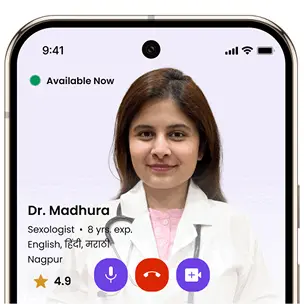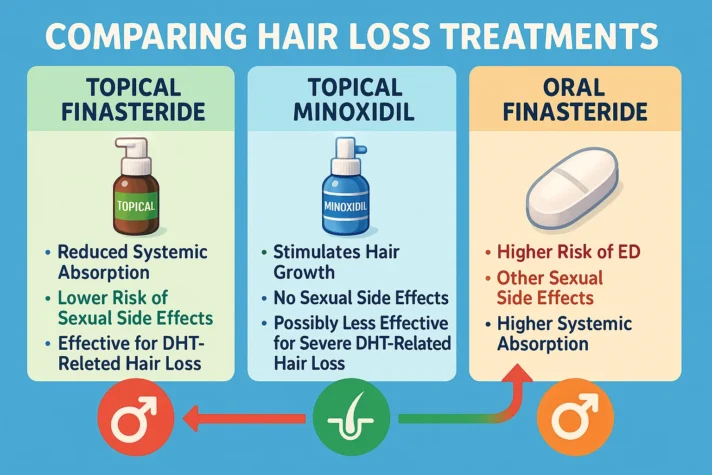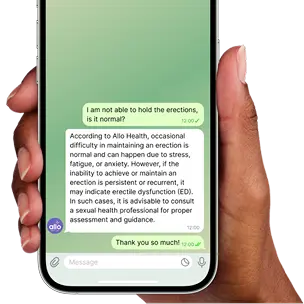Finasteride and Erectile Dysfunction: Side effects, and link with libido & fertility
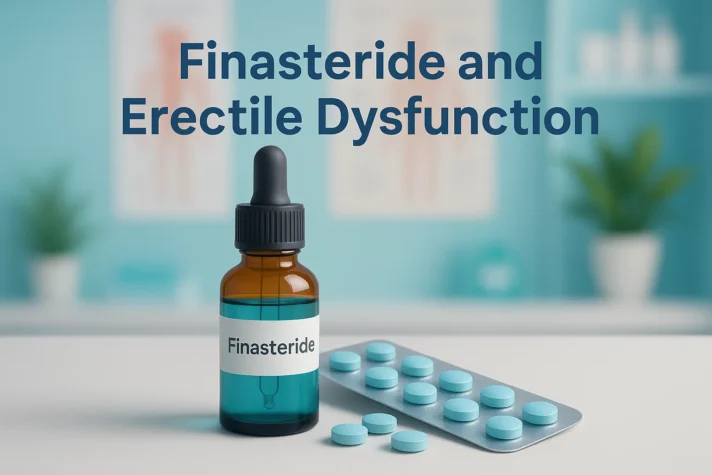
Topical finasteride is a hair loss treatment that is applied directly to the scalp, with fewer systemic side effects compared to oral finasteride. While the risk of erectile dysfunction (ED) is generally lower with topical use, it is not eliminated. Some users may still experience sexual side effects, including reduced libido and erectile dysfunction, especially with long-term use or higher doses. However, these side effects are less common and often reversible once the medication is discontinued. It's important to monitor any changes in sexual health during treatment and consult your healthcare provider if any issues arise.
Topical finasteride for erectile dysfunction is a concern for many considering this treatment for hair loss.
Finasteride is known to reduce hair loss, especially male pattern hair loss. There are growing concerns about its sexual health side effects, also. The link between topical finasteride and erectile dysfunction (ED) has been a topic of debate for years among healthcare providers and patients.
Oral finasteride is more linked to sexual side effects like erectile dysfunction. It is unclear if topical finasteride has the same risk as well. Oral finasteride is absorbed into the blood faster and more easily. Topical finasteride enters the skin layers slowly when applied.
Pattern hair loss affects millions. Knowing the side effects of treatments is very important when starting hair loss treatment as a male. In this article, we will delve deep into how topical finasteride works, the potential risk of ED, and whether these side effects are reversible. Additionally, we will address how finasteride erectile dysfunction can be managed and what steps you can take to minimize adverse effects.
What Is Topical Finasteride and How Does It Work?
Topical finasteride is a medicine used to treat male pattern hair loss or androgenetic alopecia. To make it easier for you, let’s break it down for you. “Androgenic” is related to androgens or male sex hormones, and “alopecia” is hair loss.
Topical finasteride is a treatment for hair loss that you apply directly to your scalp, not like the oral version, which you swallow. Topical finasteride is applied to the skin surface. Less of the drug enters your body. This may cause fewer side effects, like erectile dysfunction, than the pill form.
When it comes to topical finasteride, the chances of experiencing erectile dysfunction are generally much lower compared to the oral version. But, just like with any medication, it’s important to pay attention to how your body responds, and let your doctor know if you notice any changes.
Finasteride works by blocking an enzyme called ‘5-alpha reductase’, which changes testosterone into another hormone called DHT. This conversion of testosterone to DHT (dihydrotestosterone) is a key process in male pattern baldness.
DHT is the main cause of hair loss because it shrinks hair follicles, making them unable to grow hair properly. Hair follicles are the source of hair. By reducing DHT in your scalp, finasteride can help slow hair loss and even encourage new hair growth for some people.
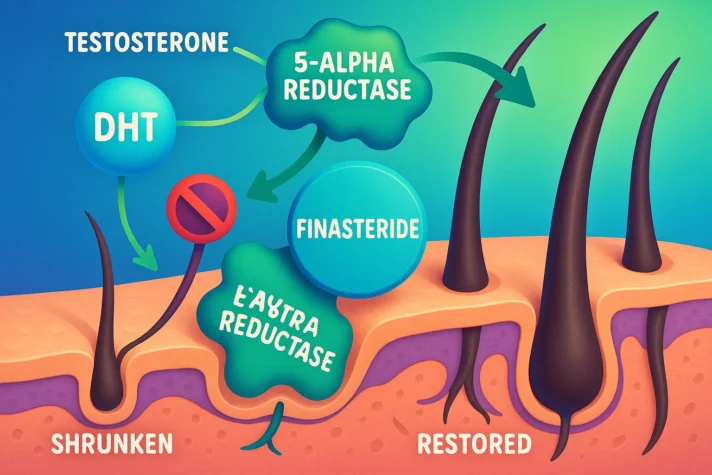
Because topical finasteride only works on the scalp and isn’t absorbed much into the body, it’s less likely to cause the same sexual side effects that the oral version can.
This makes it a good option for people who want to grow their hair without worrying about major side effects. Understanding how this hair loss drug functions at the scalp level is important for clinical practice decisions.
Can Topical Finasteride Cause Erectile Dysfunction?
Many patients ask if topical finasteride can cause erectile dysfunction like oral finasteride does.
In a 2021 study using a 0.25% topical finasteride spray, only 2.8% of people reported sexual side effects like erectile dysfunction (ED) and reduced libido or sexual desire. This was lower than the 4.8% rate seen with the oral form of finasteride. The rate in the topical group was similar to the placebo group (those who received a non-active treatment). Other recent studies also show that topical finasteride doesn’t seem to cause many sexual side effects compared to a placebo.[1]
Chances are quite rare that topical finasteride may cause ED.
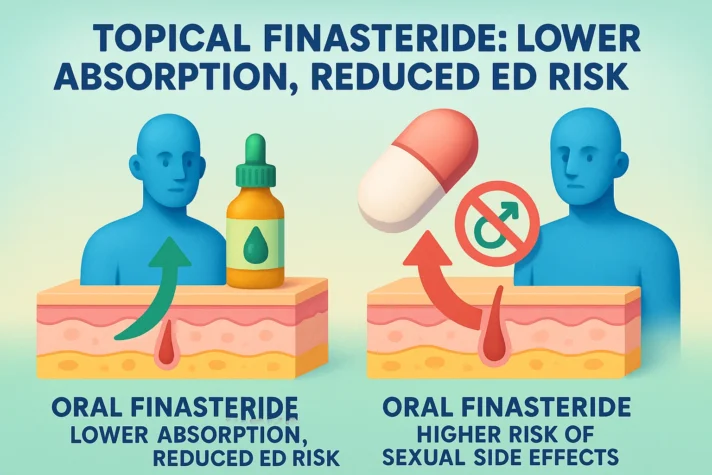
Topical finasteride is absorbed into the body at a lower rate than oral finasteride, but the chances of sexual side effects are lower. So, it’s still possible for some people to experience erectile dysfunction or other side effects, especially with long-term use or higher doses. Even with topical use, the medication can still affect hormone balance. Using topical finasteride may lower side effects. But it does not remove the risk.
Clinical studies have shown results of events with topical applications. The nocebo effect or negative effect may also contribute to reported sexual effects in some cases. Healthcare professionals must consider how each person responds when checking treatment success. They use follow-up questionnaires during long-term monitoring.
Common Sexual Side Effects of Finasteride
Even though topical finasteride is applied to the skin, users may still have sexual side effects and other problems. These include:
1. Reduced libido or sexual desire
A decrease in sexual desire is one of the most commonly reported sexual effects of finasteride therapy.
Reports show sexual side effects like low libido (3.1–5.4%), erectile dysfunction (4.9–15.8%), and ejaculation problems (2.1–7.7%). Rates vary by study. In everyday use (real-world settings), these side effects tend to happen more often.[2]
2. Delayed ejaculation and ejaculation disorder
Some users say they have trouble with ejaculation (reaching the peak of sexual pleasure and then releasing semen) and reaching orgasm. This side effect can affect sexual satisfaction. Ejaculatory dysfunction represents one of the more concerning aspects that require medical attention when reported.
3. Erectile dysfunction
ED is less common with topical finasteride but not impossible, and may require medical attention in some cases.
Erectile dysfunction with topical finasteride is rare. One study found 2.8% of topical users had sexual side effects, compared to 4.8% of oral users. Most studies show no substantive risk above placebo for topical formulations. [3]
It is important to understand that these side effects are not guaranteed to occur in every user. They can vary greatly from person to person, depending on individual responses to the drug and various other factors. Clinical trials have documented these effects, though the nocebo effect or negative effect may also play a role in some reported cases. Female pattern hair loss research has also contributed to our understanding of finasteride side effects across different populations.
Systemic Absorption/Blood Absorption Concerns and Erectile Dysfunction
When you apply something to your skin (topical administration), it doesn’t get absorbed into your bloodstream as much as when you take it by mouth (oral intake). So, less of it enters your body.
One of the main benefits of topical finasteride is that it is absorbed into the body much less than oral finasteride. When you apply it directly to the scalp, only a small amount enters the bloodstream. This is called systemic absorption, wherein the medicine reaches the bloodstream. Even tiny amounts of the drug can still reach the bloodstream and might, in rare cases, cause erectile dysfunction if the levels are high enough.
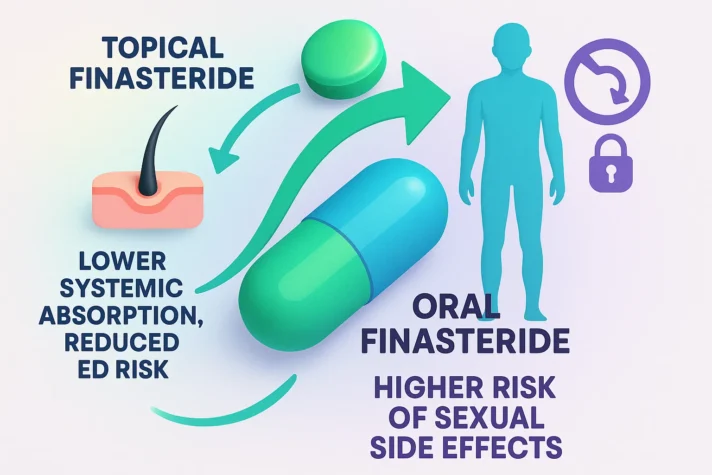
Studies show that topical finasteride has much less impact on the body than the oral version. However, in rare cases, even small amounts of the drug entering the bloodstream can affect hormones and cause sexual side effects, like erectile dysfunction. If you notice any changes in your sexual health while using topical finasteride, it’s important to contact your doctor right away. They might check your blood levels to see how the treatment is affecting you.[5]
Can erectile dysfunction caused by finasteride be reversed?
People worried about finasteride causing erectile dysfunction ask if the problem can be reversed. For most people, erectile dysfunction caused by finasteride, including topical use, goes away after they stop the medicine. But the time it takes for erectile function to return to normal can vary over an extended period.
Some users say they improve within weeks after stopping finasteride. Others may have lasting sexual side effects. Treatment efficacy varies among individuals, and so does the recovery process.
In a study of people who kept having erectile dysfunction (ED) after stopping finasteride, only a small number of users experienced lasting ED. For most people, the ED went away after they stopped taking the medication.[6]
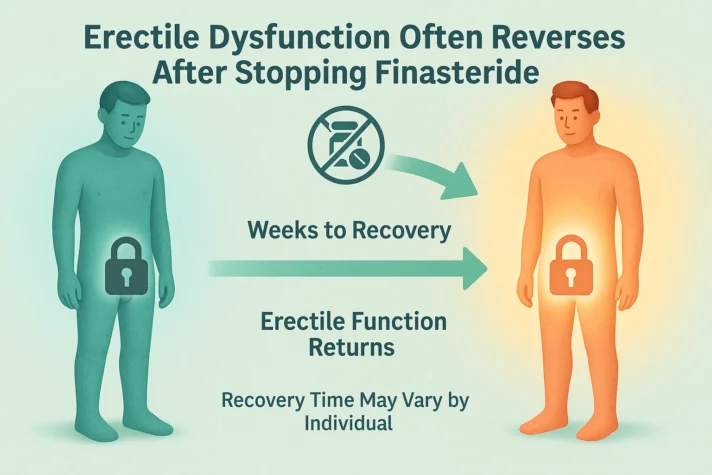
In most cases, discontinuing the drug will allow normal erectile function to return, though there are rare instances where side effects may persist for longer periods. Doctors usually tell patients to be patient during recovery. They may use follow-up questionnaires to check progress.
Can Finasteride Increase Libido or Sexual Desire?
While erectile dysfunction can be a concern for some people using finasteride, others wonder if it might increase libido. In general, finasteride is not known to boost sexual desire or function. Instead, it’s more commonly linked to a decrease in libido, or sexual desire, and in some cases, depressed mood.
However, some people may not experience any changes in their libido or sexual desire because everyone reacts differently to the medication. For others, lowering DHT levels with finasteride might reduce sexual desire and, in some cases, cause feelings of depression. If you notice a significant change in your sex drive after starting topical finasteride, it’s a good idea to talk to your doctor. The hair cycle and growth phase may also influence how patients perceive positive effects of treatment versus potential side effects.
Factors that increase the risk of developing Erectile Dysfunction with Topical Finasteride
Several factors can increase the likelihood of developing erectile dysfunction with topical finasteride, including:
1. Genetic Predisposition
Some individuals may be more sensitive to the hormonal changes caused by 5-alpha reductase inhibitors. 5-alpha reductase inhibitors are a class of medications that include finasteride. If you have a history of sexual dysfunction or hormone imbalances, you may be more prone to side effects. Animal studies have helped researchers understand these genetic variations in drug response.
2. Long-Term Use
Topical finasteride is often suggested for those who want to avoid body-wide side effects. But long-term use can still cause hormone changes that affect sexual health. Patients and healthcare professionals need to understand the long-term safety of topical finasteride.
3. Higher Dosages and Application Frequency
Using more finasteride than recommended, by mouth or on skin, or applying it more often than told, can raise the risk of side effects. These side effects include erectile dysfunction. How often and how you apply the drug can affect its benefits and side effects. Proper application schedule adherence is crucial for optimal results.
4. Individual Patient Factors
Treatment results and side effects can differ a lot between patients using finasteride and those using a placebo in studies. Androgenetic alopecia patients may respond differently based on their health profile. Individual responses to treatment can vary significantly, and comparison to patients in clinical trials may not always reflect real-world outcomes.
FDA (Food and Drug Administration) Warnings and Consumer Reports on Erectile Dysfunction
The FDA has issued warnings about the potential sexual side effects of finasteride. They may include both oral and topical forms. While the occurrence of erectile dysfunction is low, the FDA says that these risks exist, particularly with long-term use. The Medicines and Healthcare products Regulatory Agency has given similar advice about these drugs.
The Food and Drug Administration (FDA) has noted that while topical finasteride shows promise, it’s important to take care of any possible side effects. On April 22, the FDA issued a warning about 32 cases of side effects linked to people who used topical finasteride between 2019 and 2024. These cases involved consumers who bought and used the product.[7] The Adverse Event Reporting System helps track these reports and informs regulatory decisions.
Some people report experiencing erectile dysfunction with topical finasteride, although it’s less common than with oral finasteride. Before starting treatment, it’s important to consider the benefits of hair restoration alongside the potential risk of sexual side effects. Healthcare providers usually talk about these risks with patients. They may give a patient alert card with important safety details. Treatment-related adverse events should be carefully monitored throughout therapy.
Comparing Topical Finasteride with Other Hair Loss Treatments
When thinking about topical finasteride for hair loss, it helps to compare it with other treatments like topical minoxidil and oral finasteride.
| Treatment Type | Efficacy (AGA) | Typical Sexual Side Effects | Systemic Absorption/Blood Absorption | Key Notes |
| Oral finasteride | High | 2–15% of users | High | FDA-approved, most data available |
| Topical finasteride | Similar | 0–2.8% of users | Very low | Lower risk, not FDA-reviewed |
| Minoxidil (topical) | Moderate | None significant | None | Well tolerated |
| Dutasteride (oral) | High | 5–25% (some studies, higher than finasteride) | High | Not FDA-approved for AGA |
1. Topical Minoxidil
This treatment helps stimulate hair growth and improve blood flow to hair follicles. It doesn’t usually cause erectile dysfunction or sexual side effects. However, it may not be as effective for people with significant hair loss caused by DHT. Many people use minoxidil treatment alongside other treatments for better results. Minoxidil works differently as it doesn’t target the hormonal aspect of hair loss. It can be easily incorporated into a daily hair care routine and often shows visible improvements in hair density over time.
2. Oral Finasteride
The oral version is more likely to cause erectile dysfunction and other sexual side effects because it gets absorbed more into the body. Topical finasteride may be a better option for those who are concerned about these risks but still want to see results. The efficacy of finasteride in oral form has been well-documented in clinical trials. Doctors must carefully watch patients on oral finasteride. Some patients may see different effects on hair loss than with topical use.
3. Other Options
Some people may try topical or oral dutasteride or other 5-alpha reductase inhibitors. These drugs also have their risks and side effects. In some cases, intralesional dutasteride may be considered as an alternative administration option. These 5-α reductase inhibitors work similarly but may have different absorption profiles. Doctors may suggest PDE5 inhibitors to treat erectile dysfunction if it happens during treatment.
Companies like Hims & Hers have made these treatments more accessible, but it’s essential to work with a healthcare professional for proper evaluation. Topical hair products should be selected based on individual needs and treatment goals. Women with alopecia or female pattern baldness need different care. Pregnant women should avoid any contact with finasteride products because of risks from paternal exposure.
Advanced Treatment Considerations
Application and Monitoring
The application of finasteride requires attention to detail for optimal results. Simple application techniques can improve patient adherence to the treatment regimen. Hours after application, the medication begins working at the scalp skin level to inhibit DHT production. Regular assessments of hair growth help track progress during weeks of treatment.
Clinical Research and Studies
Researchers have tested topical finasteride in multiple blinded, placebo-controlled studies to check its safety and effectiveness. A significant 24-week treatment period study showed promising results with minimal systemic effects. Blinded extension studies gave more long-term data. A 24-week follow-up helped researchers learn how long the treatment lasts.
Some research has examined 15 randomized, double-blind, placebo-controlled trials to establish safety profiles. One notable 4-year, randomized, double-blind, placebo-controlled trial provided extensive data on long-term use. These studies often include placebo patients for comparison and utilize follow-up surveys to track outcomes.
Safety Considerations and Special Populations
The Drug Safety Update from regulatory agencies provides ongoing guidance for finasteride-treated patients. Blood donation deferral periods may apply for those using certain formulations. Sperm concentration monitoring might be recommended in some cases, particularly during 2 years of treatment or longer.
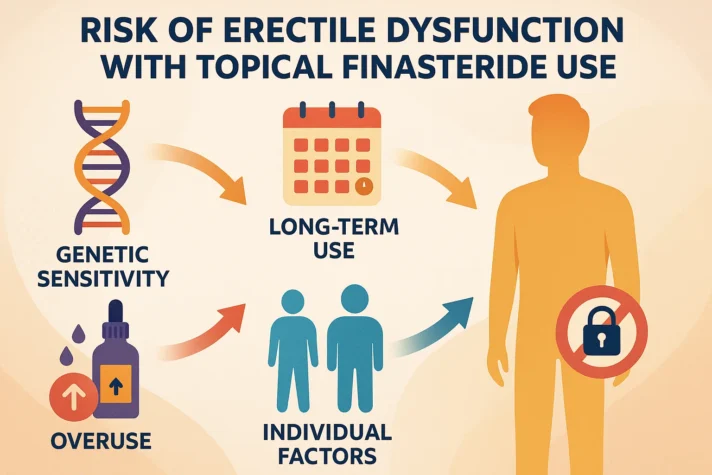
Advanced hair loss cases may require different approaches than early-stage pattern baldness. Hair follicle miniaturization can be assessed through specialized techniques to determine of treatment for hair loss. The appearance of hair loss may improve gradually as the hair cycle normalizes during therapy.
Benefits and Patient Outcomes
Many patients experience benefits to patients beyond just hair regrowth, including self-esteem improvement through enhanced appearance. Assessment in patients often reveals improvements in hair density and overall satisfaction. For those experiencing accelerated hair loss, early intervention may provide better outcomes.
The action of hair follicles can be optimized through proper treatment protocols. Some patients may consider this an effective alternative to more invasive procedures. AGA patients often report positive effects when treatment is properly managed.
Conclusion
If you want to use topical finasteride but worry about erectile dysfunction, know the risk is lower than with oral finasteride. But the risk still exists. Sexual side effects, including erectile dysfunction, can occur in some users, though they are often reversible once the treatment is stopped.
Deciding to try hair restoration should include careful thought about all treatment options. Consulting a healthcare provider before starting treatment and discussing any concerns about sexual health is crucial. Your doctor can help you weigh the benefits of better hair density and visible results against the risks of side effects.
The decision to use topical finasteride should be based on careful consideration of its benefits and risks. You should consider your health and treatment goals. With proper medical advice and monitoring, many patients can use topical finasteride for hair loss. This helps reduce possible problems while potentially achieving self-esteem improvement through effective hair loss treatment.
Doctors should use full hair loss treatment plans that balance effectiveness and safety. Topical finasteride has fewer side effects than oral forms. Knowing antiandrogen effects helps guide treatment for the best patient results.
"The following blog article provides general information and insights on various topics. However, it is important to note that the information presented is not intended as professional advice in any specific field or area. The content of this blog is for general educational and informational purposes only.
Book consultation
The content should not be interpreted as endorsement, recommendation, or guarantee of any product, service, or information mentioned. Readers are solely responsible for the decisions and actions they take based on the information provided in this blog. It is essential to exercise individual judgment, critical thinking, and personal responsibility when applying or implementing any information or suggestions discussed in the blog."

